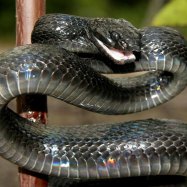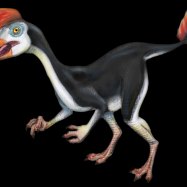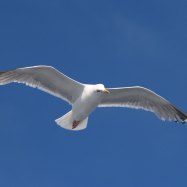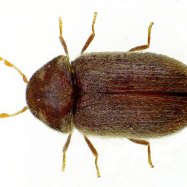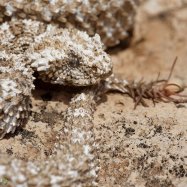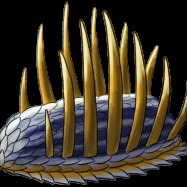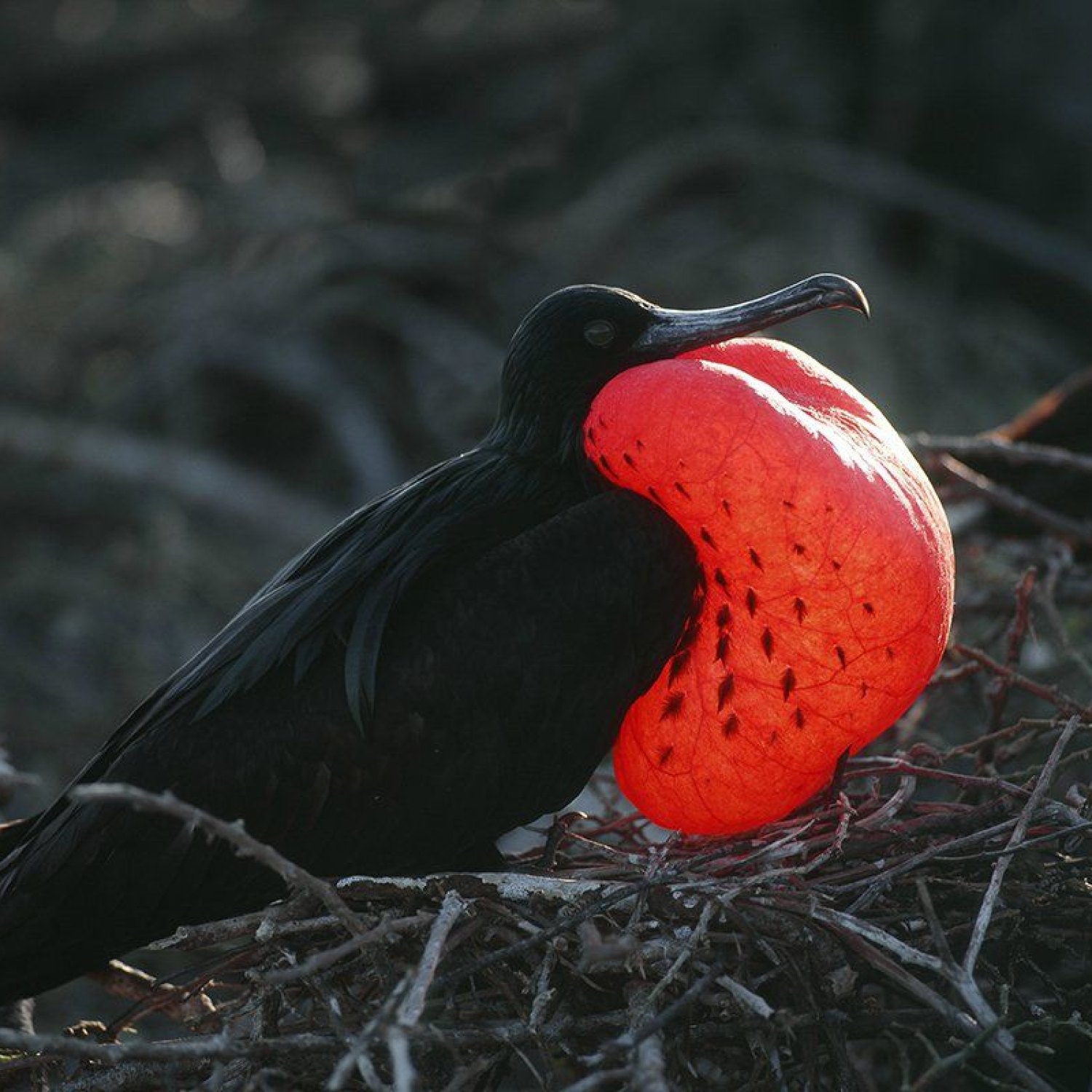
Frigatebird
85 to 105 cm (33 to 41 inches)
The Frigatebird is a magnificent creature found in the Gulf of Mexico, Caribbean, and Galápagos Islands. With a slender body, long pointed wings, and a deeply forked tail, they are known for their exceptional flying abilities. These birds can reach up to 105 cm in length and belong to the Fregatidae family. Keep an eye out for these impressive flying creatures on your next tropical adventure.
Animal Details Summary:
Common Name: Frigatebird
Kingdom: Animalia
Habitat: Coastlines, open ocean
The Mighty Frigatebird: Master of the Skies
Imagine soaring high above the ocean, with nothing but the vast expanse of blue below you. The wind ruffles your sleek, black feathers and you effortlessly glide through the air, your keen eyes scanning the surface of the water for your next meal. You are a frigatebird, one of the most majestic and fascinating creatures in the animal kingdom.Fregata magnificens, commonly known as the frigatebird, is a member of the Suliformes order and the Fregatidae family Frigatebird. These impressive birds can be found in tropical and subtropical oceans around the world, with the majority of their population residing in the Americas. They have also been spotted in the Gulf of Mexico, Caribbean, and even the famous Galápagos Islands.
But what makes these birds so special? Let's dive into the details and discover the incredible characteristics and abilities of the mighty frigatebird.
An Enviable Adaptation: The Frigatebird's Habitat
The frigatebird's primary habitat is in coastal regions and open oceans, where they spend most of their time soaring through the skies. They are excellent flyers, using their long and pointed wings to effortlessly glide for long distances without flapping their wings. In fact, they can stay in flight for weeks at a time without ever touching the ground, a feat that is envied by many birds.But why do they prefer to spend so much time in the air? The answer lies in their unique feeding method.
A Cunning Hunter: The Frigatebird's Feeding Method
When it comes to feeding, frigatebirds are true carnivores. They primarily feed on fish, squid, and other marine invertebrates, which they catch by diving into the water Flowerhorn Fish. But what sets them apart from other seabirds is their impressive hunting technique.Frigatebirds are known for their ability to snatch prey from other birds, such as gulls and terns, mid-flight. They use their impressive wingspan and agile flight to outmaneuver their unsuspecting victims and steal their catch. This hunting technique is known as kleptoparasitism and has earned the frigatebird the nickname "pirate of the skies."
But that's not all – frigatebirds are also skilled at taking advantage of other animals' hunting efforts. They often follow fishing boats and dolphins, waiting for the perfect opportunity to steal their catch. This makes them a common sight in fishing communities, where they are seen as a nuisance by some.
A Stunning Appearance: The Frigatebird's Coloration and Body Shape
One cannot help but be mesmerized by the frigatebird's appearance. They have a glossy black plumage that shines under the sun, giving them a sleek and sophisticated look. But their beauty goes beyond their coloration – their body shape is just as impressive.Frigatebirds have a slender body and extremely long and pointed wings that can reach up to 2.3 meters in span. Their wings are so long that they are often mistaken for being raptors instead of seabirds. They also have a deeply forked tail that helps them maneuver through the air with precision and speed.
This slender and elegant body shape allows frigatebirds to soar through the air with minimal effort, making them one of the best aerial predators in the animal kingdom.
A Record-Breaking Species: The Frigatebird's Length
One would expect a bird with such impressive wingspan to be enormous in size. However, the frigatebird's slender body makes it relatively small compared to other seabirds. On average, they measure around 85 to 105 cm (33 to 41 inches) in length, and they weigh only about 1.5 kg.But don't let their size fool you – they are still considered one of the largest seabird species. Their impressive wingspan and record-breaking flight abilities are what truly make them stand out among their peers.
A True Master of the Skies: The Frigatebird's Geographical Distribution
Frigatebirds are native to tropical and subtropical oceans, and they can be found in different parts of the world, such as the Americas, Africa, and Southeast Asia. However, their geographical distribution is not the only remarkable aspect of their migration patterns.These birds are known for their impressive travel skills and can travel long distances in search of food and breeding opportunities. In fact, they have the longest migration range of any bird in the Western Hemisphere, with some individuals traveling over 200,000 miles in a single year.
The Fascinating Phenomenon of Breeding Season
One of the most spectacular displays of the frigatebird's abilities can be witnessed during their breeding season. For these birds, it's not just about finding a mate – it's also a competition to attract the opposite sex.Male frigatebirds have a unique feature that they use to their advantage during breeding season – a bright red throat pouch. This pouch can inflate to an enormous size, making the males appear much larger and more attractive to potential mates. They also use this pouch to make drumming sounds, which add to their appeal.
But attracting a mate is just the beginning of their journey. Frigatebirds have a unique mating ritual that involves building elaborate nests using twigs, feathers, and other materials. The males will then display their flying and dancing skills to impress the females, who will choose the best nest and mate to continue the breeding process.
The Uniqueness of the Frigatebird: A Class of Its Own
From their incredible flying abilities and cunning hunting techniques to their mesmerizing appearance and remarkable migration patterns, the frigatebird truly stands out among the animal kingdom. They are a species in a class of their own, and their adaptability and resourcefulness have allowed them to thrive in their habitat.Through natural selection and evolution, frigatebirds have developed skills and characteristics that make them a true master of the skies. They are not only a visual treat for anyone lucky enough to see one in the wild but also a fascinating and captivating species that we should all strive to learn more about and protect for future generations to enjoy.

Frigatebird
Animal Details Frigatebird - Scientific Name: Fregata magnificens
- Category: Animals F
- Scientific Name: Fregata magnificens
- Common Name: Frigatebird
- Kingdom: Animalia
- Phylum: Chordata
- Class: Aves
- Order: Suliformes
- Family: Fregatidae
- Habitat: Coastlines, open ocean
- Feeding Method: Carnivorous
- Geographical Distribution: Tropical and subtropical oceans
- Country of Origin: Primarily found in the Americas
- Location: Gulf of Mexico, Caribbean, Galápagos Islands
- Animal Coloration: Black with a glossy sheen
- Body Shape: Slender body, long pointed wings, deeply forked tail
- Length: 85 to 105 cm (33 to 41 inches)
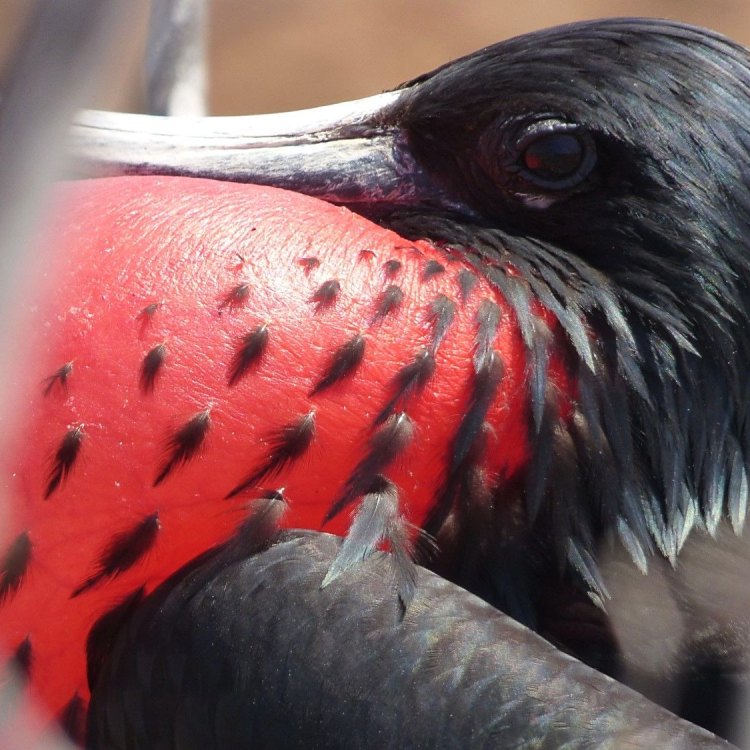
Frigatebird
- Adult Size: Large
- Average Lifespan: More than 30 years
- Reproduction: Sexual
- Reproductive Behavior: Colonial breeders, males perform elaborate mating displays
- Sound or Call: Males produce a drumming sound with inflated throat pouches
- Migration Pattern: Highly migratory
- Social Groups: Colonial breeders, form large nesting colonies
- Behavior: Aggressive towards other frigatebirds and birds of prey
- Threats: Habitat loss, disturbance to nesting colonies, predation
- Conservation Status: Least Concern
- Impact on Ecosystem: Important role in marine ecosystems as predator and scavenger
- Human Use: Tourist attraction, historically hunted for feathers
- Distinctive Features: Large wingspan, distinctive inflated red throat pouch in males
- Interesting Facts: Can spend weeks at sea without landing, known for stealing food from other seabirds
- Predator: Sharks, large fish, and terrestrial predators
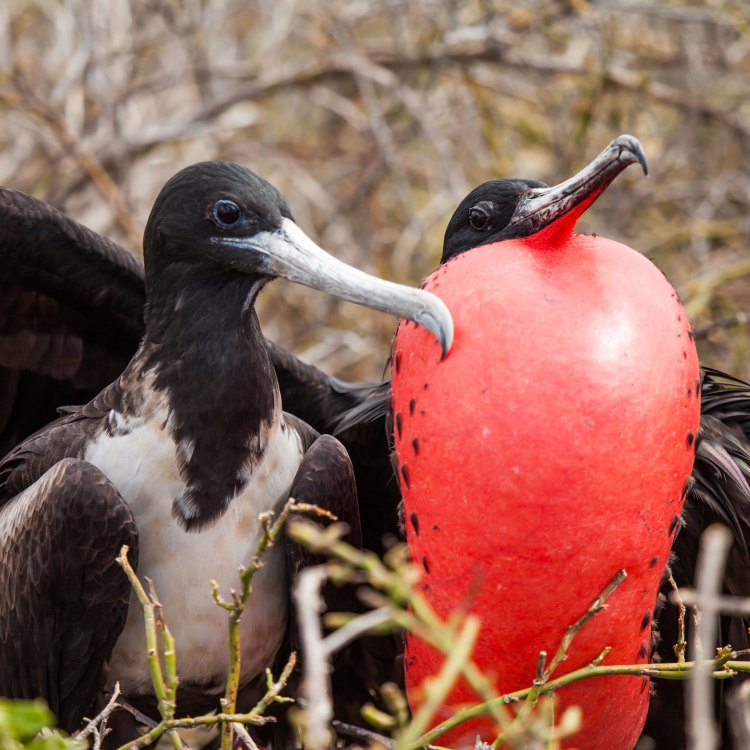
Fregata magnificens
The Magnificent Frigatebird: A Majestic Avian Species
The ocean breeze gently caresses your face as you stand on the deck of a boat, gazing out at the vast blue expanse. Suddenly, a shadow appears in the sky, growing larger and larger until you realize it is a bird, majestic and powerful, soaring through the air with ease. This is the Frigatebird, one of the most impressive and unique species of avian creatures in the world.The Frigatebird, also known as the “man o’ war bird,” is a large seabird found in tropical and subtropical regions across the globe PeaceOfAnimals.Com. With an adult size of up to 45 inches and a wingspan of over 7 feet, this bird is truly a sight to behold. They are mainly found in the Pacific, Atlantic, and Indian Oceans, but can also be spotted in some parts of the Caribbean and the Galapagos Islands.
Despite their impressive appearance and widespread distribution, many people are not familiar with the Frigatebird, which makes it all the more intriguing. In this article, we will delve deep into the unique features and behaviors of this fascinating bird, as well as its role in the ecosystem and interaction with humans.
A Bird of Longevity: Average Lifespan of 30 Years and Beyond
One of the most interesting aspects of the Frigatebird is its long lifespan. These birds have been known to live for more than 30 years in the wild, with some individuals even reaching up to 40 years of age. This is significantly longer than many other bird species, making the Frigatebird a symbol of strength and endurance.But what contributes to their longevity? It is believed that their excellent flying abilities and highly efficient metabolism play a significant role. Frigatebirds are capable of traveling long distances without rest, and they have a lower metabolic rate compared to other birds, allowing them to conserve energy and live longer Flying Squirrel.
Reproduction: An Elaborate and Dramatic Mating Ritual
Like most seabirds, Frigatebirds are sexual reproducers, meaning they require a male and female to reproduce. However, their reproductive behavior is unlike any other bird species. Frigatebirds are colonial breeders, meaning they form large nesting colonies of up to thousands of individuals.What sets them apart is the males' elaborate mating displays, which are truly a sight to behold. During the breeding season, males will inflate their bright red throat pouches and produce a loud drumming sound to attract females. This behavior is known as “gular pumping” and is used to show off the male's fitness and attract a mate.
Once a female is chosen, she will lay a single egg, which will be incubated by both parents for about 7 weeks until it hatches. The chick will then remain in the nest for another 5-6 months until it learns to fly and becomes independent.
A Highly Migratory Species with Social Habits
Frigatebirds are highly migratory birds, making them true masters of the sky. They can travel long distances, reaching speeds of up to 70 miles per hour, without flapping their wings. These birds are equipped with long, narrow wings and a forked tail, making them perfectly adapted for long-distance flights.Although they are solitary hunters, Frigatebirds are colonial breeders, meaning they form large nesting colonies. These colonies can consist of thousands of birds, making for an impressive sight. These social groups help protect the birds and their nests from predators, as well as aid in finding food and raising their young.
Aggressive and Fearless: Unique Behaviors of the Frigatebird
While Frigatebirds may seem graceful and serene in flight, they are actually quite aggressive and fearless birds. They are known to attack and harass other seabirds, such as boobies and gulls, until they drop their prey. Frigatebirds then swoop in and catch the falling food before it reaches the water.Frigatebirds are also known for their aggressive behavior towards birds of prey, such as hawks and eagles. Their large size, sharp beaks, and powerful talons make them formidable opponents, and they have been observed chasing away even the most fearsome predators.
The Threats Facing the Frigatebird
As with many animal species, the Frigatebird is facing several threats that are putting its survival at risk. The primary threat to Frigatebirds is habitat loss due to human activities. These birds often nest on remote islands, which are becoming increasingly vulnerable to pollution, climate change, and human development.Another significant threat is disturbance to nesting colonies, either by humans or invasive species. This can cause birds to abandon their nests, leaving eggs and chicks vulnerable. Predation is also a concern for Frigatebirds, with sharks, large fish, and terrestrial predators, such as cats and rats, posing a threat to both adults and young birds.
Fortunately, due to their widespread distribution and large population, Frigatebirds are currently listed as Least Concern on the IUCN Red List of Threatened Species. However, it is essential to continue monitoring and protecting their populations to prevent any future decline.
An Important Role in Marine Ecosystems
Frigatebirds play a vital role in marine ecosystems as apex predators and scavengers. They feed on a variety of fish, squid, and other marine animals, keeping their populations in check. Their habit of stealing food from other seabirds also helps to maintain a balance in the ecosystem.These birds also have an interesting relationship with dolphins. They have been observed following dolphin pods, as dolphins chasing schools of fish can create an easier hunting opportunity for the birds. In return, Frigatebirds may help dolphins locate schools of fish by keeping a lookout from above.
Hunted for Feathers: Frigatebirds' Relationship with Humans
Frigatebirds have had a long history of interactions with humans, both positive and negative. In the past, these birds were hunted for their feathers, which were highly prized for their use in decorating hats and other fashion items. This practice has now been banned, but it has significantly reduced the population of Frigatebirds in some areas.Today, these birds are more commonly seen as a tourist attraction. Their impressive flight and hunting abilities, along with their unique appearance, make them a popular sight among travelers. However, it is essential to ensure responsible tourism practices to ensure the birds' well-being and minimize disturbance to their nesting colonies.
An Inflated Red Throat Pouch and Other Distinctive Features
One of the most striking features of the male Frigatebird is its distinctive inflated red throat pouch, which is used for attracting a mate during breeding season. This pouch is made of bare skin and is thought to be a sign of health and strength. The pouch may also be used to regulate body temperature or store food.Other notable features of the Frigatebird include their large wingspan, which allows them to soar effortlessly for long periods, and their sharp, hooked beaks for capturing prey. They also have a black body with white patches on the wings, making for a striking contrast in color.
Fascinating Facts about the Frigatebird
Aside from its unique features and behaviors, there are several interesting facts about the Frigatebird that make it even more awe-inspiring. For example, these birds are capable of spending weeks at sea without landing. This is due to their ability to extract freshwater from their food, allowing them to stay hydrated while flying.Another fascinating fact is that Frigatebirds are known for their kleptoparasitic behavior, meaning they steal food from other birds. This is where their nickname “man o’ war bird” comes from, as they are similar to the old sea creature known for its thieving tactics.
In Conclusion
The Frigatebird is a truly magnificent and unique species, with its giant wingspan, inflated red throat pouch, and impressive flight abilities. Despite facing various threats, these birds have managed to survive and thrive in their oceanic habitats. They play an essential role in marine ecosystems and have a fascinating relationship with humans.As we continue to learn more about this majestic avian species, it is crucial to ensure its survival for future generations to appreciate and marvel at its beauty. Let us work together to protect and preserve the Frigatebird and all other wondrous creatures that call our planet home.
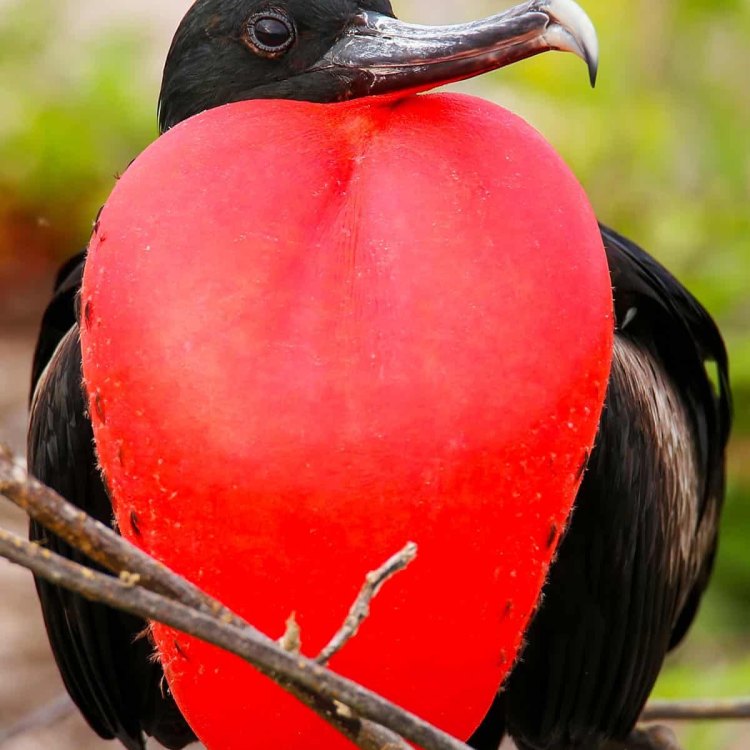
The Mighty Frigatebird: Master of the Skies
Disclaimer: The content provided is for informational purposes only. We cannot guarantee the accuracy of the information on this page 100%. All information provided here may change without prior notice.

